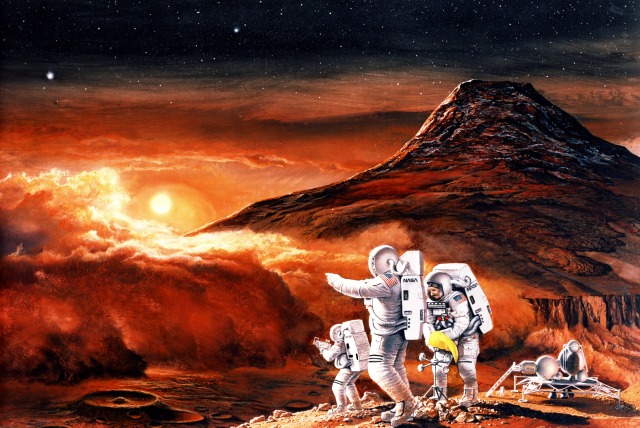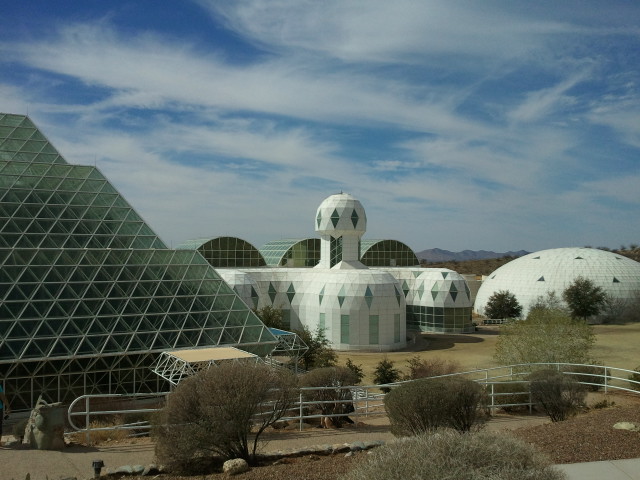
Artist depiction of humans exploring the Martian system, after 2020, by Ren Wicks. Mars advocates would like to dispatch the first expedition before 2030, but the cost and technical complexity of the mission will likely delay it.
It seems that microbial life is capable of surviving the extreme conditions of space. Even so, for Homo sapien sapiens the space environment remains remarkably dangerous to our lives. Is it a place humans might ultimately move to on a permanent basis? Is there a way forward on this objective?
One space life scientist, Vadim Rygalov, has remarked that up to now ensuring human life during spaceflight has largely been about providing the basics of human physiological needs. From the most critical—meaning that its absence would cause immediate death, to the least critical—these include such constants available here on Earth of atmospheric pressure, breathable oxygen, temperature, drinking water, food, gravitational pull on physical systems, radiation mitigation, and others of a less immediate nature.
As technologies, and knowledge about them, stand at this time, humans are able to venture into space for short periods of less than a year only by supplying all of these needs either by taking them with them (oxygen, food, air, etc.) or creating them artificially (pressurized vehicles, centrifugal force to substitute for gravity). Spaceflight would be much easier if humans could go into a hibernation during the extremes of spaceflight, as did the Streptococcus mitis bacteria.
Resolving these issues have proven difficult but not insurmountable for such basic spaceflight activities as those undertaken during the heroic age of space exploration when the United States and the Soviet Union raced to the Moon. Overcoming the technological hurdles encountered during the Mercury, Gemini, and Apollo programs were child’s play in comparison to the threat to human life posed by long duration, deep space missions to such places as Mars.
Even the most sophisticated of those earlier human spaceflights, the lunar landings of Project Apollo, were relatively short camping trips on another body in the solar system, and like most camping trips undertaken by Americans the astronauts took with them everything they would need to use while there. This approach will continue to work well until the destination is so far away that resupply from Earth becomes highly problematic if not impossible for any number of reasons.
There is no question that the U.S. could return to the Moon in a more dynamic and robust version of Apollo; it could also build a research station there and resupply it from Earth while rotating crews out on a regular basis. In this instance, the lunar research station might look something like a more sophisticated and difficult to support version of the Antarctic research stations. A difficult challenge, yes; but certainly it is something that could be accomplished with presently envisioned technologies.
The real difficulty, it seems to me, is that at the point a lunar research station becomes a colony profound changes to the manner in which humans interact with the environment beyond Earth must take place. Countermeasures for core challenges—gravity, radiation, lunar particulates, and ancillary effects—provide serious challenges for humans engaged in lunar colonization.
One avenue that NASA has pursued, but without overwhelming success as yet, is the technology of closed loop life support systems. A longstanding objective has been to build a spacecraft that could produce air, recycle water, manage waste, maintain humidity, and suppress fires. “Closing the loop” on environmental life support systems is a major technology challenge affecting the progress of human spaceflight and one that has yet to be resolved.
In 1991, environmental scientists began an experiment to test the feasibility of supporting human beings in a closed environmental system. Funded at $150 million by Texas oil magnate Edward Bass, humans at Biosphere 2 in Arizona’s Santa Catalina Mountains sought to test technologies that might be useful for sustaining life on the Moon or Mars. Designers of the three-acre facility provided for the complete recycling of water, food, and waste.
Biosphere 2’s failure as a self-contained “terrarium” supporting humans on Earth, much less one moving through the near-vacuum of space, was an eye-opener for those pursuing long-duration human spaceflight. The experiment ended badly and after 1994 no further human habitation took place. The goal of keeping people alive in an enclosed, self-contained environment whisking through space may be beyond human capabilities for many centuries.
No terrestrial explorers have ever had to contend with the all of the extremes of the space environment in their activities. For all of the other rigors of their environments, even those in quest of the poles have had breathable air, pressures that did not require suits to ensure their lives, and water/ice. Only those engaged in undersea exploration face similar difficulties of survival in such extreme conditions to which Homo sapien sapiens are ill-evolved. What might the future hold in terms of long duration, deep space exploration?



I think Biosphere 2 as a scientific experiment in biological life support left a great deal to be desired. A lot more was achieved in the Russian BIOS experiments where the focus was not so much on creating a complex ecosystem as simply providing a fairly closed loop life support system. Of course one problem is that there is pitifully little money is spent on research on issues like biological life support and ISRU. Not to mention study of issues like making space habitats a pleasant place to live – early pioneers might put up with the equivalent of life on a submarine indefinitely, but colonizers will want a quality of life at least somewhat on par with what could be obtained on Earth.
LikeLike
Thanks so much for these comments.
LikeLike
The goal of keeping people alive in an enclosed, self-contained environment whisking through space may be beyond human capabilities for many centuries.
Agreed, which is why you don’t start with Bruce Dern and his cute robots. You go where all the resources outside your sealed environment are in walking distance (but colonists on mars will use tractors. We can supply two tractors prepositioned in one lander. One day to assemble.)
It’s time we learned hands on. I’m not talking about tax money being used either. It will not cost the $6b that Mars One proposes for sending four. For $2b we could send a dozen with 3 of the same type four person landers. Let’s call it $3b for incidentals and prepositioned supplies (about $200m per 2500 kg. once the Mars One version of red Dragon has been tested.)
We know how to keep people alive in a sealed environment for long duration if we can provide for the inefficiencies. On mars, these provision do not and should not come from earth beyond getting the initial site started. The only reason we send them those two tractors, for instance, is because it will take them about a year to be able to produce them ISRU. Even longer if we don’t initially send them. They should not be forced long term to live in tuna cans. They will not be able to have the level of industry they need without the space to work in.
Oversupply and multiple solutions for each issue should be our motto. Our focus should not be on science, but on survival. When it’s time for scientists, the colonists will keep them alive. They can live on mars because it is not the sealed environment of the quote above anymore than biosphere was. The volunteers in biosphere could have died of old age if we gave them the support. On mars that support is mainly one thing…
Abundant usable energy. That gives them water and air. The initial few dozen can be completely supplied with food but will soon add to that until food is no longer an import (this may take months or years but not longer.)
It’s time to stop dipping our toes in the water and jump in. This gift to the human race is worth it.
LikeLike
Clarification: the 3 landers are waiting in mars orbit and are not the ship that transported them to mars orbit. I would propose something similar to the canceled Sundancer with upgraded life support (either two with each having life support for six or one with support for 12.) Cutting costs may require only sending 8 and having only two landers waiting. But more allows for more skills and hands to do what will be required for survival. It also reduces the psychological stress.
LikeLike
I believe that the problems highlighted in this article are only problems if we were to go about it in the wrong way. Consider how easily these problems are solved if we go about it in the right way — specifically by utilizing the ice at either the Moon or Mars.
There is absolutely no need to have a closed loop life support for either transit to Mars or on either the surfaces of the Moon or Mars. For transit to Mars the crew could eat dehydrated food and simply recycle water. For both the Moon and Mars the in situ ice greatly reduces the need for resupply. We don’t need to close all loops nor should we.
The LCROSS mission showed that the ice in the regolith is at one part per 18. If using recycling, the amounts of icy regolith needed to be processed to be able to get water, oxygen, and plant food is fairly modest.
A base on the moon should not be a research center from the get-go nor should crew be swapped out every six months as is done ISS currently. Rather, from the very beginning, the focus of the base should be on harvesting the ice. After you secure local resources everything else becomes a lot less expensive and more sustainable.
In this context, the difference between a research base, a commercial ice harvesting operation, and a settlement starts to get blurred. And this is a very good thing.
From a health standpoint, I believe that we are capable of doing a Mars flyby mission as the first step to Mars. The cosmonaut Polyakov spent the equivalent of 74% of a 589-day Mars 2021 flyby mission. From a microgravity standpoint, I believe that we are already within reach of a Mars flyby mission. If recycling water, I believe that the amount of dehydrated food we would need to take for that flyby mission would easily fit within the mass budget. From a radiation standpoint, provisions, equipment, and propellant should be positioned close to the crew. Radiation levels could be reduced by about 62% (51 gm/cm2) keeping the crew well within their career limits if older males.
On the surface of the Moon and Mars, inflatable habitats could be placed within existing craters and dirt pushed on top of them for significant shielding allowing for extended stays thereby reducing the need and cost of crew rotation.
LikeLike